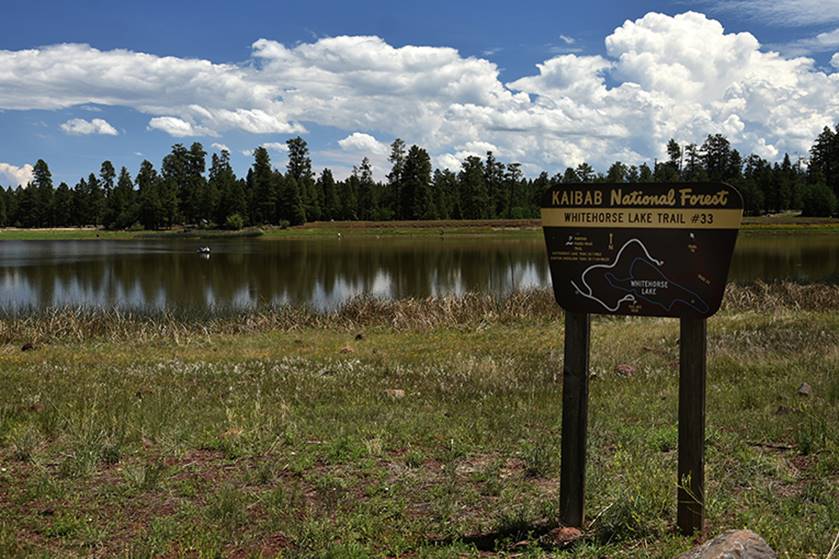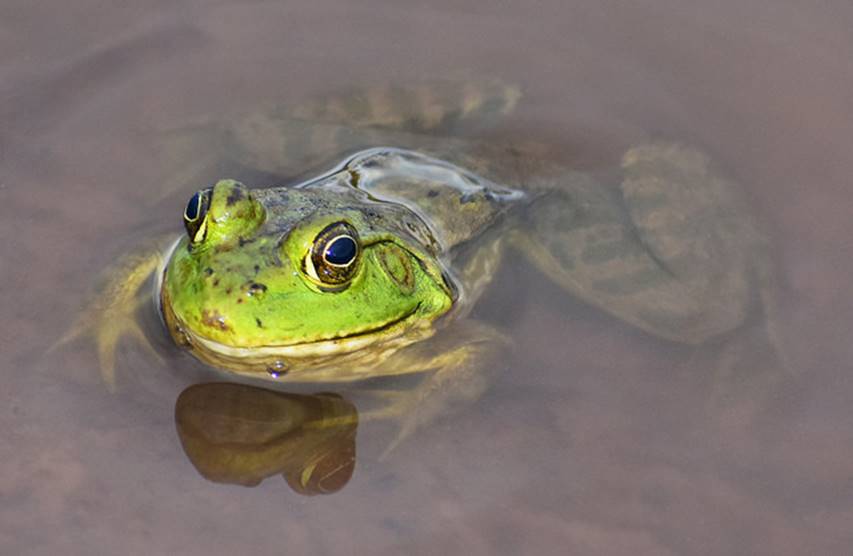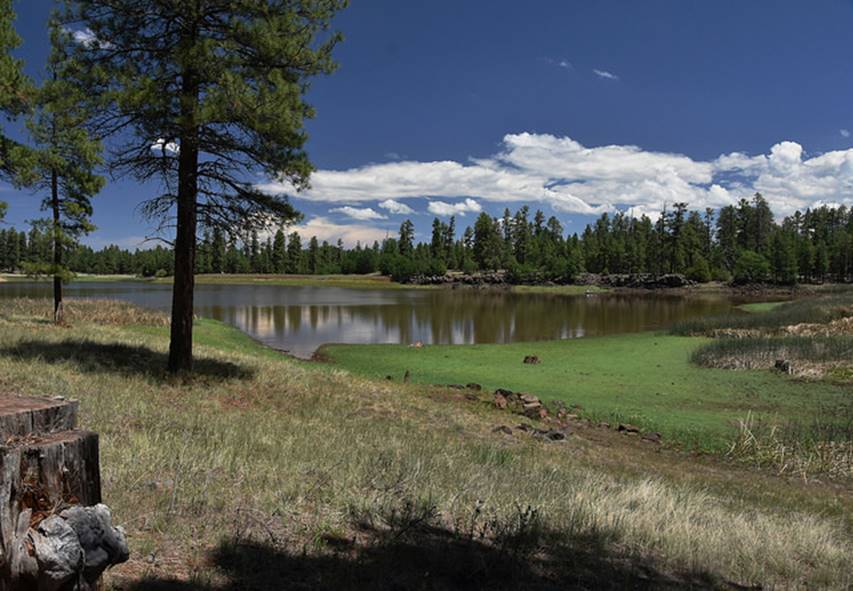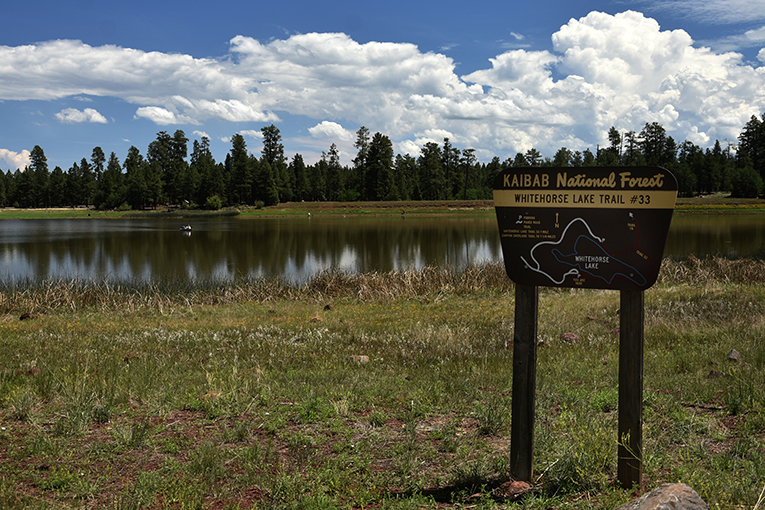|
A few photos are included below, but please see the full White Horse Lake Campground photo album at
http://bit.ly/2N62EVq for all photos and caption information. You can download the original image files from that album.
White Horse Lake offers secluded getaway for campers and day visitors
Williams, Ariz., Aug. 30, 2018—For Immediate Release. White Horse Lake Campground is one of three campgrounds on the Williams Ranger District of the Kaibab National
Forest. While the approximately 19-mile drive from the Williams area, some of which is on gravel roads, may seem daunting for some, those who brave the trip are met with breathtaking sights and remarkable recreation opportunities.
“White Horse Lake Campground is a fully developed campground that is a bit off the beaten path,” said Liz Schuppert, public services staff officer for the Kaibab National Forest. “It may take a little more time to get
there, but the solitude and scenery you’ll encounter are well worth the trip.”
The campground boasts more than 90 single-unit campsites with tables, campfire rings, grills and tent pads surrounding White Horse Lake, as well as a large group site that can accommodate 60 campers. There are also several
double sites, tent-only sites and accessible sites. Restrooms are wheelchair accessible, with some connecting to individual campsites via paved paths.
In the mornings, campers can enjoy the sun rising over the still water of White Horse Lake. Visitors may venture out onto White Horse Lake Trail #33, an easy 1-mile trail encircling the lake and providing gorgeous views
of the sunrise. Elk can often be seen browsing along this route, while frogs sunbathe along the water’s edge.
Roughly half a mile into the trail is a juncture for Sycamore Canyon Outlook Trail #70. A mere 1.25-mile hike from the juncture, hikers will be amazed to find breathtaking views into the second largest canyon in Arizona’s
red rock country. The 21-mile-long scenic Sycamore Canyon reaches a maximum width of about 7 miles.
“My favorite part of visiting White Horse is the scenery. Walking around the lake feels like stepping into a painting, especially when the flowers are in bloom,” said Kirsten Bass, Northern Arizona University student
and day-use visitor. “When I’ve visited, it’s been tranquil and refreshing. The charming views are one of White Horse Campground’s best kept secrets.”
Following the morning hike, visitors are welcome to enjoy other amenities available in the campground. Swimming is not allowed in the lake; however, small motorized fishing boats can be launched from the boat ramp. Kayaks
are available for rent, and fishing licenses are offered for sale on site. A snack shack in the day-use area serves snacks and full meals, alongside general store items. On weekends, the campground offers programs and nature walks along the lake to families.
The Public Lands Interpretive Association and Southwest Recreation have been providing interpretive services
at White Horse since 2006 through a partnership with the Kaibab National Forest. The Public Lands Interpretive Association is a not-for-profit educational organization whose mission is to inspire and educate the public about the natural and cultural heritage
resources of America’s public lands.
“The opportunities for interpretive and environmental educational activities at White Horse are exceptional,” said Deb Noel, campground interpretive program manager for the Public Lands Interpretive Association/Southwest
Recreation. “Our goal is to help instill in our visitors a sense of wonder and appreciation of the gift of our public lands.”
Over the 2018 camping season alone, interpretive programming at White Horse has included morning nature walks during which campers of all ages and abilities get to experience the wonders of the area and learn about plants,
wildlife, meteorology, geology, soils, insects, and more; discovery tables at which visitors can explore topics such as big game animals, aquatic invertebrates, tree rings, and forest health; and, an annual Smokey Bear birthday bash during which families can
hear Smokey Bear's story and learn about fire safety while also discovering fire’s critical role in the health of the area’s ponderosa pine ecosystem.
“White Horse is a great place to see and study nature because of its diversity of geography and wildlife,” Noel said. “When the lake level is high enough, it supports a nice diversity of aquatic plant life, giving waterfowl
such as coots and mallards a place to hide, which is always fun to point out to visitors. It's also a great place to sneak up on, and try to catch, frogs and tadpoles, which kids love! It’s a wonderful place to watch osprey and bald eagles fish, and dragonflies
and damselflies hunt amongst the bulrushes. You may even catch sight of gray fox, elf, deer and coyote.”
The area surrounding White Horse Lake Campground serves as a robust recreational spot, with opportunities for hikers, mountain bikers, rock climbers and ATV riders. The Sycamore Rim Trail is a particular highlight amongst
these opportunities. Running along the rim of Sycamore Canyon, the 11-mile trail can be accessed at five different trailheads. The Sycamore Falls trailhead, a mere 1.7 miles from the campground, showcases phenomenal waterfalls after monsoonal weather. The
Sycamore Rim Trail can also be accessed from the Pomeroy Tanks trailhead, which leads to a small body of water thriving with wildlife.
“While the Kaibab National Forest has campgrounds closer to town for convenience, sometimes I want to feel like I’m truly getting into nature. White Horse feels tucked away from the everyday traffic of life,” Bass said.
“I come back just for that feeling of escaping into the outdoors.”
To view photos of White Horse Lake Campground and the diverse recreational opportunities in the area, visit
http://bit.ly/2N62EVq. To learn more about White Horse Lake Campground, visit
http://bit.ly/2LICdR4.
Kaibab National Forest information is also available through the following sources:
Southern entrance of Whitehorse Lake Trail #33. This nature trail loops around the lake, linking with Sycamore Canyon Overlook Trail #70 around the backside. Photo by Adriana Petrungaro. Credit Kaibab National Forest.
An American Bullfrog seen in the waters along the eastern side of White Horse Lake. Bullfrogs relax in the area by the hundreds, eating bugs and soaking up sun rays. Photo by Dyan Bone. Credit Kaibab National Forest.
Eastern side of White Horse Lake. Elk can be seen browsing and drinking in the mornings, while frogs sunbathe along the shore during the daytime. Photo by Adriana Petrungaro. Credit Kaibab National Forest. This electronic message contains information generated by the USDA solely for the intended recipients. Any unauthorized interception of this message or the use or disclosure of the information it contains may violate the law and subject the violator to civil or criminal penalties. If you believe you have received this message in error, please notify the sender and delete the email immediately. To manage your subscription visit http://www.fs.fed.us/news/subscription.shtml |
Attachment:
1650-1_so_WhiteHorseLakeCampground_2018_0830.pdf
Description: 1650-1_so_WhiteHorseLakeCampground_2018_0830.pdf





